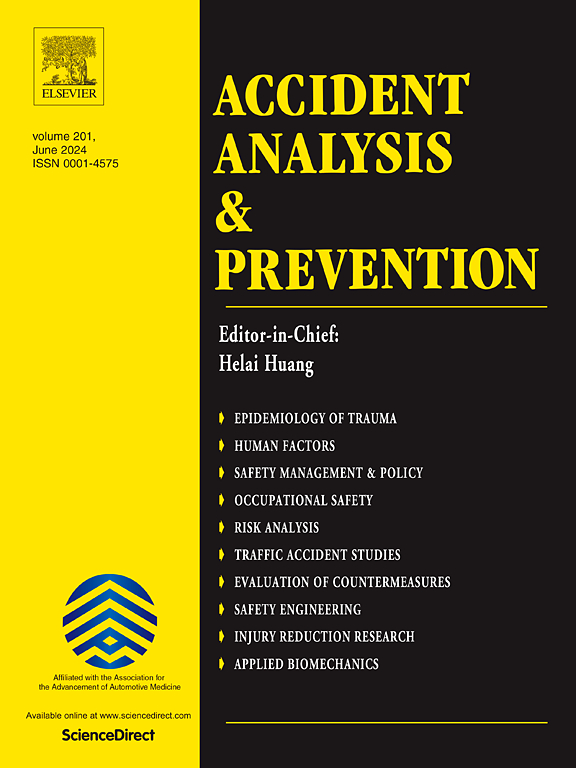Collaborative effects of vehicle speed and illumination gradient at highway intersection exits on drivers’ stress response capacity
IF 5.7
1区 工程技术
Q1 ERGONOMICS
引用次数: 0
Abstract
Inadequate visibility is a critical factor contributing to the heightened occurrence of nighttime accidents at highway intersections. The installation of smart streetlights which are equipped to detect vehicle positions and speed information, thereby dynamically adjusting illumination, offers a promising solution to significantly reduce nighttime accident rates while conserving lighting energy. Nevertheless, as vehicles travel through illuminated intersections in a relative high speed and enter unlighted highway segments, drivers often experience dynamic visual illusions during dark adaptation, consequently impairing their stress response capacity and generating driving safety concerns. Therefore, we investigate the collaborative impact of illumination gradient and vehicle speed at intersection exits on driver stress response, aiming to provide a theoretical foundation for gradual illumination designs dynamically aligning with various vehicle speeds. Specifically, with reaction time employed as a metric to quantify driver stress response, and intersection area illuminance and vehicle speed utilized as input parameters, a safety assessment method for illumination gradients at exit sections is developed using variance analysis and multiple comparison techniques. Subsequently, a high-fidelity nighttime driving simulation platform is established, integrating initial illuminance, vehicle speed, and illumination gradient distance within exit sections as influential factors. Through simulated driving experiments, the collaborative effects of illumination gradient schemes and vehicle speed on reaction time is systematically examined. Ultimately, we propose optimal illumination gradient schemes and the minimum required number of streetlights for exit sections corresponding to specific vehicle speeds. Results reveal that exit section illumination is unnecessary when the vehicle speed is below 40 km·h−1. For vehicle speeds of 50, 60, and 70 km·h−1, the minimum required exit section lengths are determined to be 35, 70, and 105 m, respectively. Moreover, it is established that a minimum of one streetlight is indispensable within the exit section at a speed limit of 50 km·h−1, while at 60 km·h−1, at least two streetlights are required. Lastly, under a speed limit of 70 km·h−1, the exit section should accommodate no fewer than three streetlights to ensure optimal safety conditions.
高速公路交叉路口出口处的车速和照明梯度对驾驶员应激反应能力的协同影响。
能见度不足是导致高速公路交叉口夜间事故频发的一个关键因素。安装智能路灯可检测车辆位置和速度信息,从而动态调整照明度,这为大幅降低夜间事故率同时节约照明能源提供了一种可行的解决方案。然而,由于车辆以相对较高的速度通过有照明的交叉路口,并进入无照明的高速公路路段,驾驶员在黑暗适应过程中往往会产生动态视觉错觉,从而影响其应激反应能力,引发驾驶安全问题。因此,我们研究了交叉路口出口处照明梯度和车速对驾驶员压力反应的协同影响,旨在为动态调整不同车速的渐变照明设计提供理论基础。具体而言,将反应时间作为量化驾驶员压力反应的指标,将交叉路口区域照度和车辆速度作为输入参数,利用方差分析和多重比较技术,开发了出口路段照度梯度的安全评估方法。随后,建立了一个高保真夜间驾驶模拟平台,将出口路段内的初始照度、车速和照度梯度距离作为影响因素。通过模拟驾驶实验,系统地研究了照明梯度方案和车速对反应时间的协同影响。最终,我们提出了与特定车速相对应的最佳照明梯度方案和出口路段所需的最少路灯数量。结果表明,当车速低于 40 km-h-1 时,出口路段不需要照明。当车速为 50、60 和 70 km-h-1 时,出口路段所需的最小长度分别为 35、70 和 105 米。此外,车速限制为 50 km-h-1 时,出口段至少需要一个路灯,而车速限制为 60 km-h-1 时,出口段至少需要两个路灯。最后,在速度限制为 70 千米/小时-1 时,出口路段应安装不少于三个路灯,以确保最佳的安全条件。
本文章由计算机程序翻译,如有差异,请以英文原文为准。
求助全文
约1分钟内获得全文
求助全文
来源期刊

Accident; analysis and prevention
Multiple-
CiteScore
11.90
自引率
16.90%
发文量
264
审稿时长
48 days
期刊介绍:
Accident Analysis & Prevention provides wide coverage of the general areas relating to accidental injury and damage, including the pre-injury and immediate post-injury phases. Published papers deal with medical, legal, economic, educational, behavioral, theoretical or empirical aspects of transportation accidents, as well as with accidents at other sites. Selected topics within the scope of the Journal may include: studies of human, environmental and vehicular factors influencing the occurrence, type and severity of accidents and injury; the design, implementation and evaluation of countermeasures; biomechanics of impact and human tolerance limits to injury; modelling and statistical analysis of accident data; policy, planning and decision-making in safety.
 求助内容:
求助内容: 应助结果提醒方式:
应助结果提醒方式:


